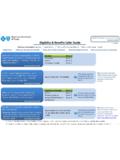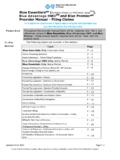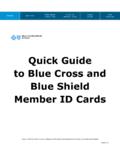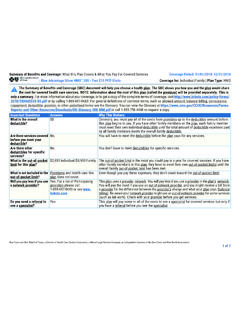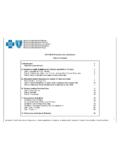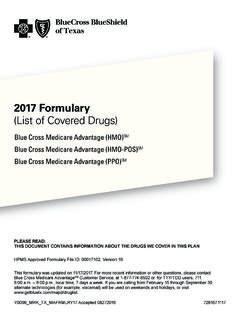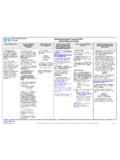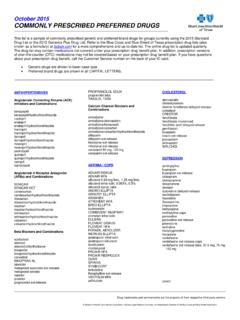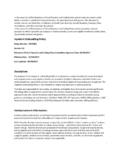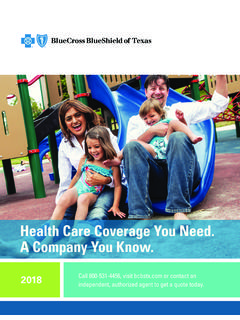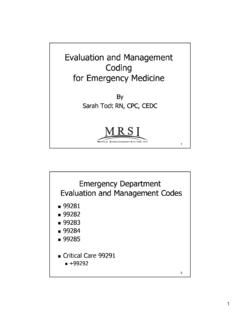Transcription of CPCP003 Evaluation and Management of …
1 1 In the event of conflict between a Clinical Payment and Coding Policy and any plan document under which a member is entitled to Covered Services, the plan document will govern. Plan documents include, but are not limited to, Certificates of Health Care Benefits, benefit booklets, Summary Plan Descriptions, and other coverage documents. In the event of conflict between a Clinical Payment and Coding Policy and any provider contract pursuant to which a provider participates in and/or provides services to eligible member(s) and/or plans, the provider contract will govern. Evaluation and Management of Emergency Department Coding Policy Number: CPCP003 Version Enterprise Clinical Payment and Coding Policy Committee Approval Date: 05/19/2017 Effective Date: 07/24/2017 Last Updated 05/19/2017 Description This Clinical Payment and Coding Policy is intended to ensure that Emergency Department Providers (facilities and physicians or other qualified health care professionals) are reimbursed based on the code or codes that correctly describe the health care services provided.
2 This policy applies to all health care services billed on the CMS 1500 forms and those billed on the UB04 forms. The information in this policy is to serve only as a reference resource regarding clinical payment policy for the Emergency Department Services described and is not intended to be all inclusive. Using the correct combination of code is the key to minimizing delays in claim(s) processing. Please ensure that revenue codes and procedure codes reflect the diagnoses and services rendered. Reimbursement Information: The patient s medical record documentation for diagnosis and treatment in the Emergency Department ( ED) must indicate the presenting symptoms, diagnoses and treatment plan and a written order by the physician should be clearly documented in the medical record. Medical records and itemized bills may be requested from the provider to support the level of care that is rendered.
3 Medical records will be used to determine the extent of history, extent of examination performed, complexity of medical decision making (number of diagnoses or Management options, amount and/or complexity of data to be reviewed and risk of complications and/or morbidity or mortality) and services rendered. This information will be reviewed in conjunction with the level of care billed and evaluated for appropriateness. Applicable service codes: Revenue code 450 and/or one of the following procedure codes 99281, 99282, 99283, 99284, 99285, 99288, 99291, 99292, G0380, G0381, G0382, G0383, and G0384. 2 If observation services are billed with any of the ER associated Evaluation and Management codes, MCG Criteria will be used to evaluate the medical necessity of these observation hours. Coverage is subject to the terms, conditions, and limitations of an individual member s programs or products and the Clinical Payment and Coding Policy criteria listed below.
4 The ED provides services to patients who are there for immediate medical attention. The physician or other qualified healthcare professional level of service is determined by the following: Forward Complexity (99281/G0380):The presented problem(s) are self-limited or minor conditions with no medications or hometreatment department visit for the Evaluation and Management of a patient, whichrequires these 3 key components:1)A problem focused history;2)A problem focused examination; and3)Straightforward medical decision and/or coordination of care with other physicians, other qualified health care professionals, or agencies are provided consistent with the nature of the problem(s) and the patient's and/or family's needs. Usually, the presenting problem(s) are self-limited or minor. Complexity (99282/G0381):The presented problem(s) are of low to moderate severity. Over the counter (OTC)medications or treatment, simple dressing changes; patient demonstrates understandingquickly and easily.
5 Emergency department visit for the Evaluation and Management of apatient, which requires these 3 key components:1)An expanded problem focused history;2)An expanded problem focused examination; and3)Medical decision making of low and/or coordination of care with other physicians, other qualified health care professionals, or agencies are provided consistent with the nature of the problem(s) and the patient's and/or family's needs. Usually, the presenting problem(s) are of low to moderate severity. Complexity (99283/G0382):The presented problem(s) are of moderate severity. Emergency department visit for theevaluation and Management of a patient, which requires these 3 key components:1)An expanded problem focused history;2)An expanded problem focused examination; and3)Medical decision making of moderate and/or coordination of care with other physicians, other qualified health care professionals, or agencies are provided consistent with the nature of the problem(s) and the patient's and/or family's needs.
6 Usually, the presenting problem(s) are of moderate severity. 3 Complexity (99284/G0383):Usually, the presented problem(s) are of high severity, and require urgent Evaluation by thephysician but do not pose an immediate significant threat to life or physiologic department visit for the Evaluation and Management of a patient, whichrequires these 3 key components:1)A detailed history;2)A detailed examination; and3)Medical decision making of moderate and/or coordination of care with other physicians, other qualified health care professionals, or agencies are provided consistent with the nature of the problem(s) and the patient's and/or family's needs. Complexity (99285/G0384):The presented problem(s) are of high severity and pose an immediate significant threat tolife or physiologic function. Emergency department visit for the Evaluation and managementof a patient, which requires these 3 key components within the constraints imposed by theurgency of the patient's clinical condition and/or mental status:1)A comprehensive history;2)A comprehensive examination; and3)Medical decision making of high and/or coordination of care with other physicians, other qualified health care professionals, or agencies are provided consistent with the nature of the problem(s) and the patient's and/or family's needs.
7 Usually, the presenting problem(s) are of high severity and pose an immediate significant threat to life or physiologic function. direction of Emergency Medical Systems (EMS) emergency care, advanced lifesupport. (99288) Care (99291) & 99292 The assignment of the Critical Care code 99291 likewise follows the same instructionsapplicable to the six E&M codes listed above. There is a 30 minute time requirement forfacility billing of critical care. The first 30-74 minutes equal code 99291. Any additional 30minute increments beyond the first 74 minutes is coded )The administration and monitoring of IV vasoactive medications (such as adenosine,dopamine, labetalol, metoprolol, nitroglycerin, norepinephrine, sodiumnitroprusside, etc.) is indicative of critical for ED Facility CPT Coding/HCPCS The table below has three columns in the guidelines. The far left column indicates the facility codes and corresponding APC levels which are justified by the "Possible Interventions" listed in the middle column.
8 The far right column labeled "Potential Symptoms/Examples which Support 4 the Interventions" is simply used as an aid to the coder in determining which interventions most likely correspond with a given facility code/APC level. This far right column of "Potential Symptoms/Examples" is not used to determine the appropriate facility code/APC level. The determination of the appropriate facility code/APC level is based solely on the "Possible Interventions" listed in the middle column. The "Possible Interventions" refer to interventions on the part of the nursing and ancillary staff in the Emergency Department and not to interventions by the emergency physicians. Possible Interventions" includes some procedure examples which might be billed separately by the facility. The procedures listed serve as a proxy, qualifying the typical intensity of facility services provided for patients requiring them.
9 Such procedure examples are not intended to substitute for or duplicate labor, time or supplies included in separately billable procedures. Levels of "Discharge Instructions" are defined in the last section of these guidelines. The appropriate facility code/APC level is determined by the interventions (of nursing and ancillary ED staff) as listed in the middle column marked "Possible Interventions". If a given "Possible Intervention" is listed in a section assigned to a specific facility code level, and if no other interventions are provided that fall into a higher facility code level, then the facility code level corresponding to that specific "Possible Intervention" is selected as the appropriate "facility code/APC level". Within a given facility code/APC level, there may be multiple "Possible Interventions" provided, all of which fall into the same facility code/APC level.
10 Whether there is a single "Possible Intervention" or multiple "Possible Interventions"-all of which fall into the same facility code/APC level-the appropriate facility code/APC level to be assigned remains the same. In other words, whether only a single "Possible Intervention" listed at a given facility code level is present or if multiple or all "Possible Interventions" assigned to that facility code level are present-the facility code/APC level is still the same. In the "Possible Interventions" column, the first sentence states, "Could include interventions from previous (lower) levels, plus any of:" This simply means, for example, that if the highest facility code/APC level achieved by any "Possible Intervention" is a facility code 99283 and APC level 614, then the appropriate facility code to assign is a 99283. The presence of "Possible Interventions" from levels 99281 and/or 99282 in addition to the "Possible Intervention" listed in the 99283 section has no effect on the facility code level assigned.
